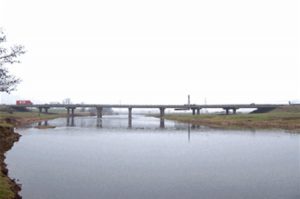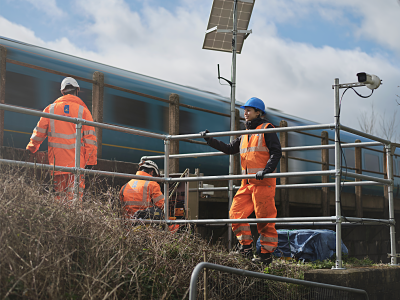Bridging troubled waters: Bristol University champions infrastructure resilience in the face of climate change
Bridges are a key part of our infrastructure. The UK alone is home to thousands of them, from small centuries-old masonry bridges in tiny villages to gleaming, towering structures sprawling across cities and bodies of water. Each plays a vital role in linking communities, trade and the flow of day-to-day life, so when something goes wrong with a bridge, the impact can be extensive.
It was this critical significance that drew Bristol University’s Dr Maria Pregnolato into her field of research. After completing a PhD focusing on flooding and infrastructure, she turned her attention to bridges, their resilience in the face of climate change, and the potential society-wide consequences that will loom large should these structures go inadequately managed.
“From a research point of view, it’s a fascinating area,” says Maria. “Every bridge is different and faces its own unique set of risks – there are lots of variables involved.” Many of these risks stem from the impact of climate change: increased flooding leading to high levels of erosion, for example. Aging is also a problem, especially in the UK where we are frequently reliant on bridges that are sometimes hundreds of years old. These structures – and indeed those built even in the 20th century – simply aren’t cut out for the way we use them today. There are more cars on the road than ever before, while lorries are bigger, heavier and make more frequent journeys – and this is only set to increase.
An unclear picture
Despite the obvious risks involved in bridge failures, there’s no national database collating information on the UK’s bridges and their specific threats (unlike the US, where it is a legal requirement for relevant parties to record their bridge data). “It would be a big challenge,” Maria explains. “There are so many different bodies in the UK managing their own bridges: Highways England, Network Rail, Transport for Scotland, Transport for Wales, plus the local councils managing their own structures. All the information is disjointed.”
Expand your knowledge
This means the scale of the issue at hand is unclear. Recent reports from transport policy and research organisation RAC Foundation suggests more than 3,000 bridges across England, Scotland and Wales can be classed as ‘substandard’, although the data is far from comprehensive. “We don’t have the full picture,” says Maria. “But we do know the situation is not improving.”
Indeed, headlines detailing costly – and sometimes fatal – bridge collapses are becoming increasingly common. In the year leading up to autumn 2020, for example, 10 bridges across the UK fully collapsed, while a further 30 partially collapsed.
As Maria notes, there is no ‘one size fits all’ approach to bridge monitoring and maintenance, but she hopes that her research will help authorities better understand the wide-spread impacts of bridge failure and, hopefully, create a business case for investment in the remit. “That’s another area where we don’t have much data,” she says. “We need figures to demonstrate the return of an investment in resilience, so it becomes a more attractive proposition.”
Making the business case for resilience

A key project guiding this area is a collaboration Maria undertook with the University of Washington (Seattle, USA) and Highways England. Here, she drew upon the roads and flooding risk model she developed for her PhD and integrated bridges into the mix. The case study examined the flood-prone UK city of Carlisle, and investigated its M6 Bridge for vulnerability to hydrodynamic flows. “We worked with Bristol University’s School of Geography to simulate flood depths and flood velocity, then used computational fluid dynamics to understand the behaviour of different forces on the structure, and the impact on the structure itself.”
Finally, the team took a ‘big picture’ view of the economic impact of the bridge failing. The analysis showed more than £500k of damages of which >90% indirect damages (traffic rerouting and delays). Without the bridge, vehicles would have to take alternative routes, causing personal and business economical losses.
“It’s clear that if the bridge fails, there aren’t just going to be costs related to the repair and replacement of the bridge, but a whole raft of indirect costs stemming from delays and business losses.” And of course, longer journeys mean more emissions – something councils keenly want to avoid.
Making monitoring easier

Maria and her team are now working on developing measures that make bridge monitoring easier, safer and more cost-effective, so trouble can be identified before it becomes a serious problem. Traditionally, bridge monitoring would be conducted visually, by a team of divers. “But this isn’t always safe,” says Maria. “Plus it can be a long process and finding people with the right skills can be a challenge.” Instead, digital sensors are set to take over.
“We’re currently examining the merits of using digital sensors on bridge structures to examine scour, or erosion, which is the number one cause of bridge failures around the world,” Maria explains. “We already know these devices can be effective, so our most recent task was identifying exactly which sensors are most appropriate for use in this way, since there are many on the market.”
As such, Maria and her colleagues have developed an innovative rating system for scour sensors comprising five criteria: ease of installation, ease of operation, ease of data capture, ease of data interpretation and measurement frequency. Each criteria is scored from 1 to 5 based on a given framework – the higher the score, the more suitable it is for that particular structure.
This project is currently being trialed in collaboration with Network Rail and James Fisher Testing Services at three railway bridge locations in Wales. The first phase of the project is complete, with sensor deployment next on the agenda. “This project could make a very important difference to the way bridge infrastructure is managed in the UK,” says Maria.
And it can’t come soon enough. With some analysts calling infrastructure resilience a ‘time bomb issue’, Maria agrees that there is a sense of urgency around the matter. “Our bridge infrastructure is not going to get better on its own,” she says. “Without action now I think we will have a very pressing agenda within five years.”


